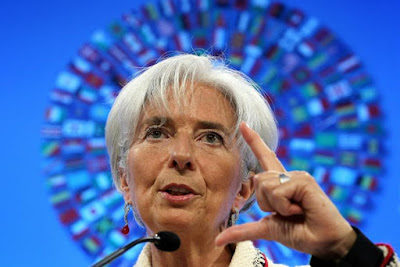Overview: Last week's bond market rally has stalled. Benchmark 10-year yields are up 1-3 bp in Europe, and the three bp increase in the US puts the yield slightly below 1.50%. Equities were mixed in the Asia Pacific region. Japan, Hong Kong, South Korea, and Australia nursed losses after the regional benchmark (MSCI) rose 0.65% last week. The Stoxx 600 had a seven-session rally in tow, but it is little changed in the European morning. It rose 1.65% last week. US futures indices are hovering around little changed levels after new record highs were set before the weekend. The US dollar is narrowly mixed. The New Zealand dollar and Norwegian krone are the strongest of the majors. The Swedish krona, Swiss franc, and sterling are struggling. The yen and euro
Topics:
Marc Chandler considers the following as important: 4.) Marc to Market, 4) FX Trends, bonds, Brexit, China, Currency Movement, Featured, infrastructure, Japan, newsletter, Oil, USD
This could be interesting, too:
Nachrichten Ticker - www.finanzen.ch writes Die Performance der Kryptowährungen in KW 9: Das hat sich bei Bitcoin, Ether & Co. getan
Nachrichten Ticker - www.finanzen.ch writes Wer verbirgt sich hinter der Ethereum-Technologie?
Martin Hartmann writes Eine Analyse nach den Lehren von Milton Friedman
Marc Chandler writes March 2025 Monthly
Overview: Last week's bond market rally has stalled. Benchmark 10-year yields are up 1-3 bp in Europe, and the three bp increase in the US puts the yield slightly below 1.50%. Equities were mixed in the Asia Pacific region. Japan, Hong Kong, South Korea, and Australia nursed losses after the regional benchmark (MSCI) rose 0.65% last week. The Stoxx 600 had a seven-session rally in tow, but it is little changed in the European morning. It rose 1.65% last week. US futures indices are hovering around little changed levels after new record highs were set before the weekend. The US dollar is narrowly mixed. The New Zealand dollar and Norwegian krone are the strongest of the majors. The Swedish krona, Swiss franc, and sterling are struggling. The yen and euro are little changed. Emerging market currencies are also mixed to start the new week. The freely accessible and liquid emerging market currencies are mostly lower, with the South African rand a notable exception. The JP Morgan Emerging Market Currency Index is posting small gains for the second consecutive session and the fourth in the past five. It rose almost 0.5% last week. Rising yields seem to be sapping gold's luster. It made a new high near $1821 before backing off. Oil prices are firm. Recall that last Thursday, December, WTI was sold to almost a one-month low near $78.25. The lack of follow-through on Friday saw a strong close and additional gains to nearly $82.60. Russian gas shipment to Europe was expected to increase this week after Gazprom finished rebuilding domestic stocks, but there is no sign of it. On the contrary, Gazprom has indicated that there will be no spot sales this week. Natural gas prices in Europe (Dutch benchmark) is up around 6% today.
Asia Pacific
China reported stronger than expected exports in October and weaker than anticipated imports. The net result was a record trade surplus of $84.5 bln. Total exports this year have now surpassed last year's total. Exports of machines and electrical products accounted for almost 60% of China's exports by value. Labor-intensive goods, such as clothing and plastics, accounted for another 18%. Iron ore imports were off 4.2% year-to-date, the first decline in this year. Coal imports rose 1.9%. It appears that the supply chain disruptions may have helped boost Chinese exports. The record surplus, however, did not lead to much reserve growth. October reserves rose by $17 bln to $3.217 trillion. It was the first increase since July. It leaves reserves about $1 bln higher than at the end of last year. It appears that businesses and banks are sitting the "missing" dollars.
Japan's Prime Minister Kishida has talked about a new capitalist model, and today a report was released that may anticipate the large fiscal stimulus package expected before the end of the month. It does not seem like a new model as much as a broad government investment strategy and a strengthening of the dirigism state (a directive role for the state, not just regulatory). It will emphasize digital, green, and chip technology, according to reports. It will help incubate startups and will seek to address the disparities of wealth. The report seems to propose some government subsidies of wages via larger tax breaks for companies that increase wages and additional support for small and medium-sized businesses that boost compensation even if losing money. Separately, we note that Japan reported no covid deaths for the first time in 15 months.
The dollar is pinned new the lower end of the range that has prevailed against the yen since mid-October (JPY113.25-JPY113.30). Resistance is now seen in the JPY113.70-JPY114.00 area. We have suspected that the new range for the greenback is JPY113.00- JPY114.50/JPY115.00. Yet, a break of JPY113.00 could see stop-loss sales that push the dollar toward JPY112.50. After falling to around $0.7360 after the US jobs data, the Australian dollar recovered and settled slightly above $0.7400. Follow-through buying today has been limited to nearly $0.7415. Initial resistance is seen near $0.7420 and then $0.7435. The Chinese yuan is slightly firmer but within the range set on the last session in October (~CNY6.3888-CNY6.4078). The PBOC set the dollar's reference rate a firmer than the bank models (Bloomberg) projected: CNY6.3959 vs. CNY6.3937. Although the yuan is in a narrow range against the greenback, against the CFETS trade basket that the PBOC monitors, the yuan reached its best level since January 2016 last week.
Europe
Europe faces two challenges. First, Europe again has emerged as the epicenter of the virus; Germany, Greece, Ireland, Romania, and Bulgaria have been hard hit. French President Macron will address his country tomorrow. Mask protocols continue, and the vaccine passport requirement will continue into H2 22.
The second challenge is the unfinished work with Brexit. There is speculation that when COP-26 concludes, the UK will invoke Article 16 of the Northern Ireland Protocol to force a thorough re-writing of the protocol, which a former adviser to the UK government has suggested there was no intention on adhering to in the first place. There are nuances of the law and limitations of how Article 16 can be applied. Issues like the role of the European Court of Justice may not be covered. Meanwhile, the EU, or at least parts of it, seems to threaten the UK-EU trade pact if the UK triggers Article 16. The rub here is that it would require a unanimous decision from the EU's 27 members.
The Sentix Investor Confidence in the eurozone rose to 18.3 in November from 16.9 in October. The assessment of the current situation deteriorated slightly (23.5 vs. 26.3), but the expectations (projection of economic sentiment six months) rose to 13.3 from 8. The current assessment is the weakest since June. The expectations are the strongest since August.
UK Prime Minister Johnson's approval rating has fallen to a new record low, according to the poll in the Observer. Parliament is holding an "emergency" debate over the government's initial attempt to protect a Tory MP found to have violated lobbying rules. Of course, Labour jumped on it though it was the Lib Dems who secured today's debate. The real threat came from conservative media outlets and former Prime Minister Major.
The euro is in about a quarter-cent range above $1.550, where a 470 mln euro option is stuck at expires. Options for another billion euros expire there tomorrow. On the top side, the $1.1580 area offers initial support. There are 550 mln euro of options at $1.16 that roll off today, which also corresponds to the 20-day moving average. Note that the (50%) retracement of the decline since testing the $1.1690 area at the end of October is found slightly above $1.1600. In late September, sterling recorded the low for the year just ahead of $1.3400. At the end of last week, between the miscue by the Bank of England (where Bailey seemed to blame the market for not appreciating the conditionality to his hawkish signals), the threat of the UK-EU trade agreement, and the stronger than expected US jobs data, sterling fall to roughly $1.3425 before recovering smartly back to $1.3500. Sterling's low today (~$1.3450) was seen in late Asia. However, it has recovered to test $1.3500 again. Resistance will likely be encountered in the $1.3530-$1.3560 area.
America
It says something about the US political climate that investing in the physical infrastructure is associated with center-left politics. Even the patron saint of capitalism, Adam Smith, recognized infrastructure as a legitimate responsibility of the state. Leave aside America's own bipartisan political tradition for infrastructure and the fact that the Republican president General Eisenhower insisted on the Federal Highway Act sixty-five years ago. The fact of the matter is that the forces of nationalism itself favor investing in US infrastructure, which has been slipping in international rankings. The World Economic Forum report (2019), often cited benchmark, put the US infrastructure in 13th place. IMD World Competitive 2021 rankings show the US has fallen from first place in 2018 to 10th place this year and last. It is not just about the economy. The US is 33rd among the OECD's 36 members for infant mortality, 46th globally for longevity, and 78th for female participation in the labor market.
The US 10-year Treasury yield fell 14 bp after initially edging higher after the FOMC meeting. It fell to almost 1.42%, its lowest level since late September, after the stronger than expected employment report. There are four things that most of the narratives seem to miss. First, the dramatic fall in US rates was more than matched in many foreign markets. That means the interest rate differentials moved in the US favor. The 10-year premium over Germany rose almost 8 bp. The premium over the UK rose 10 bp to the most in two months. Second, the fall in the bond yields can be fully explained by the adjustment in short-term rate expectations (a proxy for policy). The implied yield of the December 2022 Eurodollar futures fell almost 14 bp last week. The December 2022 short-sterling interest rate futures saw its implied rate collapse by 33 bp. Not to be left out, the December 2022 Euribor futures implied interest rate fell by 19 bp. Third, many of the observations shared in the press, and social media do not recognize market positioning. Speculators went into the FOMC meeting with their largest net short position since March 2020. Moreover, some of the shorts were in weak hands because the Commitment of Traders report shows that the bears added about 21.8k contracts to their gross short position, the biggest weekly increase in six months. The speculative position was net long as recently as early October. Fourth, the dollar value of negative-yielding bonds rose every day last week (the first time since July). It rose by almost 28% last week to $13.7 trillion. It appears to be the biggest increase in five years and makes the paltry US yield more attractive.
OPEC+ has rejected the US request to boost output. Although some media reports accuse the oil producers of not caring about the energy shortage, this is not to take OPEC+ arguments seriously. It maintains that the problem is not the lack of oil supply but the jump in gas and coal prices, which it has no influence over. The Biden administration has threatened some unspecified action but has suggested that selling some of its 600 mln barrel strategic reserves is possible. Apparently, tomorrow's monthly survey from the EIA may impact the decision. Meanwhile, the Saudis have boosted the sales price of their oil. Oil is in steep backwardation, which means that the price for near-term delivery is higher than deferred contacts. The December 2021 WTI is near $82.40, while the December 2022 contract is $10 lower. Drawing down strategic reserve may be most effective if joined by other countries. Japan is a potential ally in this.
With last week's FOMC meeting behind us, the silence period has ended, and Fed officials take to the public stage. With a light economic calendar for North America today, Fed speeches will grab the attention. Clarida speaks first on monetary policy. Then, Powell delivers the opening remarks at the Fed's diversity conference. Harker, Bowman, and Evans also talk about the economy and monetary policy.
After recovering smartly on November 4 from around CAD1.2380 to slightly above CAD1.2470, the US dollar edged up to CAD1.2480 ahead of the weekend to test the 200-day moving average. It is little changed today in a narrow band around CAD1.2450. There are chunky options near there over the next two sessions ($1 bln at CAD1.2460 tomorrow and $580 mln at CAD1.2455 on Wednesday). A quiet, if choppy consolidation session is likely for North America. The greenback slumped almost 1% against the Mexican peso ahead of the weekend. It has come back a bit firmer from the weekend. Initial resistance is seen near MXN20.43 and then MXN20.47. Mexico reports October CPI figures tomorrow, and a 25 bp rate hike is widely expected to be delivered Thursday, the fourth such move in the cycle that began in June.
Tags: #USD,Bonds,Brexit,China,Currency Movement,Featured,infrastructure,Japan,newsletter,OIL








